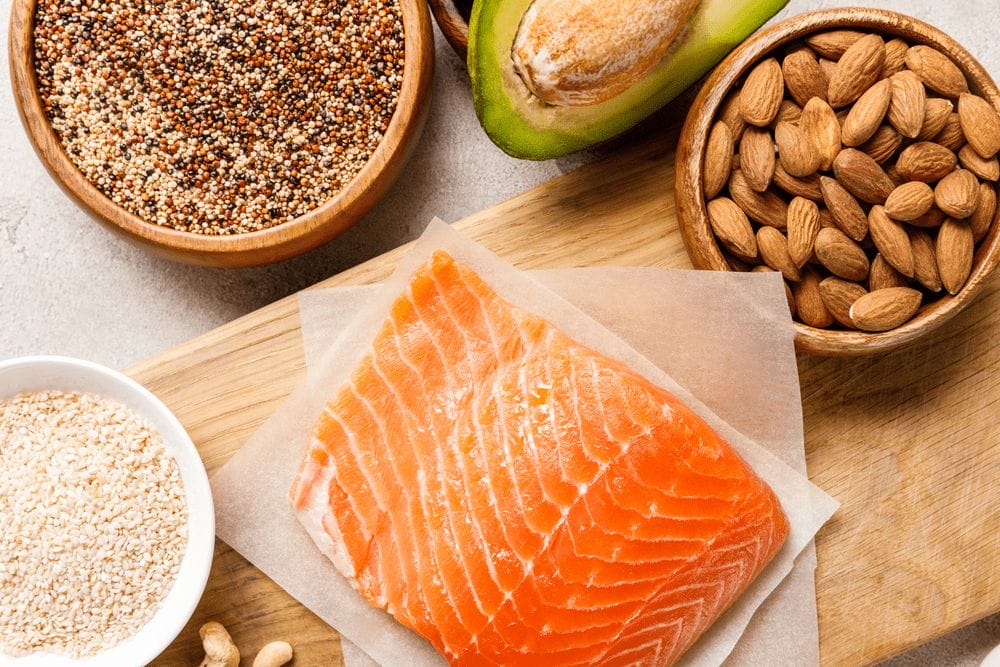Protein benefits apply to everyone, not just bodybuilders and high-level athletes. Your body needs protein to stay lean and strong, recover from workouts, and generally live a healthy life regardless of your age or fitness goals.
But in a culinary culture dominated by sweets, fats, and junk food of all kinds, fulfilling that recommended daily protein number is easier said than done. So it’s time to prioritize protein in your diet and reap the benefits of this essential nutrient moving forward.
Consuming plenty of protein doesn’t have to be a pricey or labor-intensive process, either! Without the hassle, let’s list eight practical ways to get more protein in your diet.
1. Learn to Count Grams of Protein
Most folks don’t take the time to look at the nutrition panel on their groceries, let alone acknowledge the number of protein grams per food serving.
For example, did you know that there are 35 grams of protein in a 4-ounce chicken breast? How about 6 grams of protein in an egg? There are nearly 20 grams in a heaping cup of greek yogurt!
Learn the basics and know-how to boost your protein intake without the guesswork.
2. Make Protein the Main Event
We’re not saying you need to become a nutrition scientist or count every macronutrient to the letter. However, knowing the amount of protein in everyday food items will give you an edge when improving your diet.
This will also help you prioritize protein at mealtime or when searching for snacks. You’ll reach for the mixed nuts instead of chips or grab a cottage cheese cup instead of a granola bar.
These small changes make a big difference at the end of the day, and change the trajectory of your health for the better in the long term.
3. Get Used to Eating Eggs
There are many ways to make eggs taste great and fit with your meal plan. Eggs are affordable, easy to digest and give you a much-needed energy boost if you’re aiming to keep calories low.
You can even make a half-dozen hard-boiled eggs and keep them in the fridge for easy access. Once you learn the art of the egg, you’ll see it’s a vital part of your protein game plan.
4. Look into Lean Dairy Products
Everyone handles dairy differently, but lean cheeses and yogurts are generally easier on the stomach and the calorie count. These products are loaded with protein and feel-good enzymes that keep your mood balanced while dieting.
If you don’t get along too well with dairy, start with small amounts and work your way up. You may also find that cottage cheese, kefir, and other fermented products are more cooperative during digestion and great for your gut as well.
Getting more protein requires that you be a bit more adventurous with your diet, so step outside your comfort zone and see what you find!
5. Rotate Protein Sources at Meals
Chicken breast again? Another night of ground beef and rice? Don’t let that be you. There are so many excellent protein sources out there, and your job is to keep the rotation interesting enough so you don’t get bored.
Learn about various cuts of beef, test out new types of seafood, and experiment with different styles of cooking and spices. Protein is the centerpiece of cuisines worldwide, so let this be the gateway to discovering new ways of cooking and enjoying food.
6. Check Out Non-Animal Protein
Maybe you’ve had enough of the chicken, beef, or fish for a while. You’re in luck because plant-based proteins are plentiful in our modern era, and they can taste great with proper preparation.
Lentils and various legumes are always a good pick and don’t overlook classics like tempeh and tofu for a meatier texture.
Even if you’re not vegetarian or vegan, these products are worth incorporating into your lineup, if only for variety’s sake.
7. Try a Personalized Protein Powder
You don’t want to go without protein powder when starting a new chapter for your health. Of course, the typical grocery store stuff is acceptable, but why not get a protein powder that fits your preferences to perfection?
Find a product that meets your needs on every level, with the right ingredients, amino acid profile, performance boosters (like collagen or creatine), and more.
8. Think Beyond the Protein Shake
Remember that protein powder doesn’t always need to be mixed into a shake. Instead, add it to oatmeal, yogurt, tea, or make tasty baked goods from scratch.
When you realize the versatility of protein powder as a key ingredient, you’ll find it far easier to hit that protein RDA every day.
See What Protein Does for You
Getting enough protein is not an arbitrary recommendation. When you get the amount you need, you’ll see fundamental changes in your body – on the scale and in the mirror.
Commit now and watch the changes begin for the better.
Throughout the year, our writers feature fresh, in-depth, and relevant information for our audience of 40,000+ healthcare leaders and professionals. As a healthcare business publication, we cover and cherish our relationship with the entire health care industry including administrators, nurses, physicians, physical therapists, pharmacists, and more. We cover a broad spectrum from hospitals to medical offices to outpatient services to eye surgery centers to university settings. We focus on rehabilitation, nursing homes, home care, hospice as well as men’s health, women’s heath, and pediatrics.








